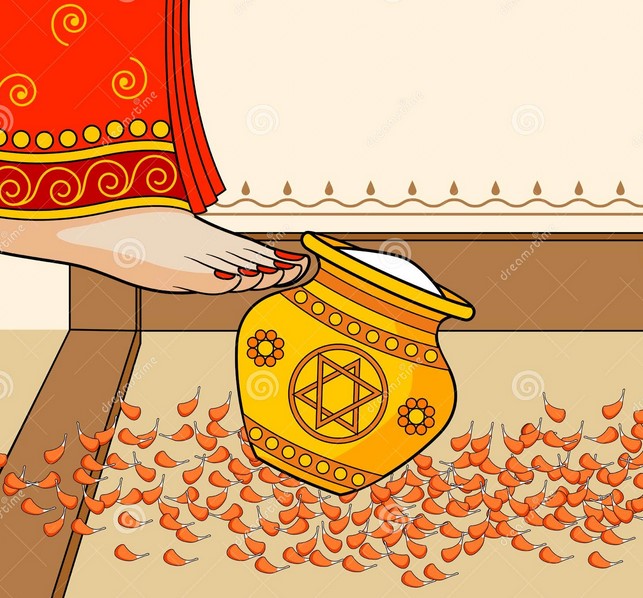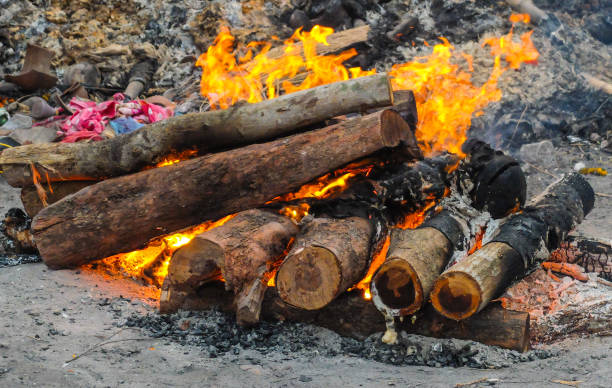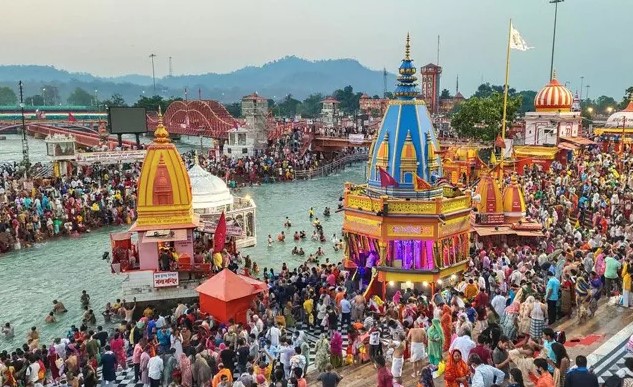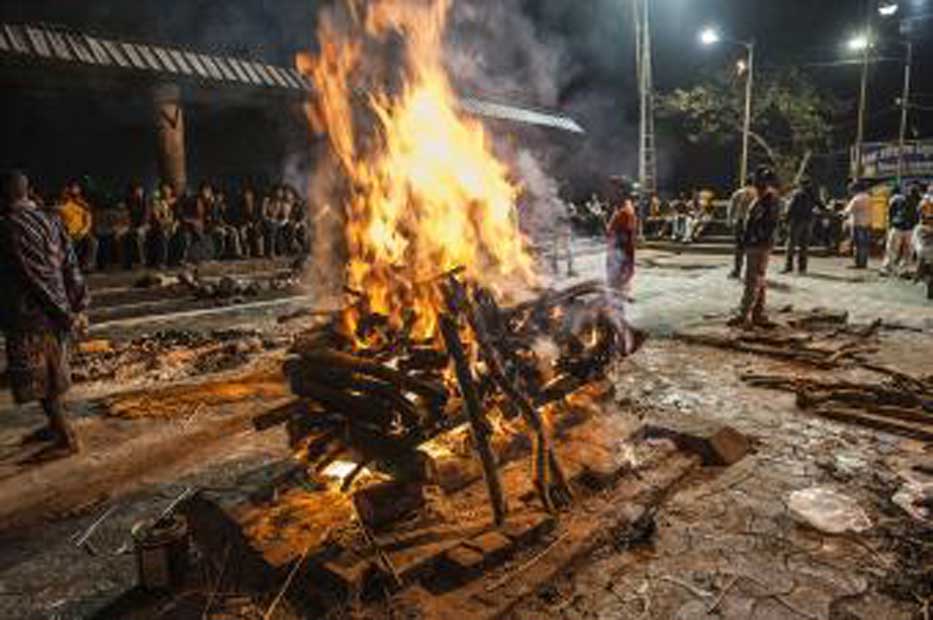Post Wedding Grah-Pravesh Ceremonies : After the Grah Pravesh (the ceremonial entry of
the bride and groom into the groom’s house) following the wedding, several traditional rituals are performed to welcome the bride into her new home and strengthen the bond
between the couple and their families. The specific rituals may vary according to regional
customs and family traditions, but here are some common Post Wedding Grah-Pravesh Ceremonies performed after Grah Pravesh:
1. Aarti and Welcome Ceremony:
- Aarti: Upon entering the groom’s home, the groom’s mother or elder women of the
house perform an aarti (a ceremonial welcome with a lighted lamp) for both the bride and groom. This wards off negative energy and blesses the couple.
- Rice or Wheat Grains: Sometimes, a pot filled with rice or wheat grains is placed at the
entrance, which the bride gently kicks as she enters. This symbolizes prosperity and abundance entering the home with the bride.
2. Kalash or Pot Ritual:
- A kalash (pot) filled with rice is placed at the doorstep. The bride gently kicks it with her right foot while entering the house. This signifies her role as the bringer of prosperity and abundance into the household.
3. Stepping into Red-Colored Water:
- In some traditions, the bride steps into a plate filled with red-colored water
or kumkum mixed with water), then walks into the house leaving red footprints. These footprints symbolize the arrival of Goddess Lakshmi (the goddess of wealth and prosperity) into the home.
4. Puja or Worship Ceremony:
- A brief puja (worship ceremony) is usually conducted to bless the new couple and the household.
The couple is asked to sit together as the priest or elders chant mantras and offer prayers
for the couple’s long, prosperous, and happy married life.
5. Rice Throwing (Anna Prashan) Ritual:
- The bride may perform the rice-throwing ritual, where she throws handfuls of rice or
food grains behind her while entering the house. This symbolizes that she will be
responsible for maintaining and nourishing the family and that she leaves behind
abundance and prosperity in her family.
6. Games and Fun Rituals:
Post-wedding games between the bride and groom are a common tradition across many Indian cultures. These games lighten the atmosphere, bring joy, and help the newlyweds get comfortable in their new roles.
- Ring Game: A popular game involves placing a ring or a coin in a bowl of milk, water, or flowers,
and the couple is asked to find the ring. The one who finds the ring first playfully dominates the relationship.
Untying of Knots: The bride or groom may untie the sacred thread, symbolizing the successful conclusion of the wedding rituals.
Click here to see more about Rituals and Traditions
7. Vadhu Paksh Bhoj (Bride’s First Meal):
- The groom’s family often prepares a special meal and offers it to the bride in her new home. This is her first meal as part of the new family, and the family ensures that she is treated with love and respect.
8. Mooh Dikhai (Introduction and Gifts):
- In Mooh Dikhai (literally “showing the face”), the bride is introduced to all the close relatives of the groom’s family. Each relative offers her blessings and presents her with gifts such as clothes, jewelry, or money. This ritual is an important gesture of acceptance of the bride into the groom’s family.
Click here to see more about Rituals and Traditions
Post Wedding Grah-Pravesh Ceremonies
9. Suhag Thaal Ritual:
- The bride is presented with a Suhag Thaal, which contains various items symbolizing her status as a newly married woman. These items may include bangles, sindoor (vermilion), bindi, comb, and mirror. The groom’s mother or other senior women of the house help the bride in donning these items as part of her married status.
10. Cooking Ritual (Paath Phere or Muh Dikhai Bhoj):
- In some families, there is a tradition where the bride is expected to cook her first meal in her new home, usually a simple dish like sweetened rice (kheer or halwa) or a traditional family dish. This ritual signifies her role in the family as the new homemaker.
11. First Night Ritual (Suhaag Raat):
- After all the welcoming rituals and celebrations, the couple is traditionally led to their room for their Suhaag Raat or “First Night.” The room is decorated with flowers, especially roses, and the couple is given privacy to spend their first night together as a married couple.
12. Pag Phera Ritual:
- The Pag Phera is another post-wedding ritual where the bride returns to her parental home for a brief stay after her first night at the groom’s house. Traditionally, this happens on the third or fourth day after the wedding. After spending some time with her family, the groom comes to take her back, marking her full integration into the groom’s family.
13. Blessings from the Elders:
- The elders continuously bless the couple, symbolizing their acceptance and hopes for a prosperous, happy married life.
14. Reception:
- Usually, the groom’s family hosts a reception after the Grah Pravesh, inviting extended family members, friends, and associates to bless the newlyweds and celebrate their union.
Each of these rituals is significant in its own way, representing the love, respect, and new responsibilities that come with marriage. The bride’s entry into her new home marks the beginning of a new chapter in her life, and these traditions help ease the transition while fostering family bonds.
Post Wedding Grah-Pravesh Ceremonies
गृह प्रवेश – शादी के बाद की रस्में :
शादी के बाद गृह-प्रवेश समारोह: शादी के बाद गृह प्रवेश (दूल्हा और दुल्हन का दूल्हे के घर में औपचारिक प्रवेश) के बाद, दुल्हन का उसके नए घर में स्वागत करने और जोड़े और उनके परिवारों के बीच के बंधन को मजबूत करने के लिए कई पारंपरिक अनुष्ठान किए जाते हैं। विशिष्ट अनुष्ठान क्षेत्रीय रीति-रिवाजों और पारिवारिक परंपराओं के अनुसार अलग-अलग हो सकते हैं, लेकिन यहाँ गृह प्रवेश के बाद किए जाने वाले कुछ सामान्य विवाह-पश्चात अनुष्ठान दिए गए हैं:
आरती और स्वागत समारोह:
- आरती: दूल्हे के घर में प्रवेश करने पर, दूल्हे की माँ या घर की बड़ी महिलाएँ दूल्हा और दुल्हन दोनों के लिए आरती (दीप जलाकर स्वागत) करती हैं। यह किसी भी नकारात्मक ऊर्जा को दूर करने और जोड़े को आशीर्वाद देने के लिए किया जाता है।
- चावल या गेहूँ के दाने: कभी-कभी, चावल या गेहूँ के दानों से भरा एक बर्तन प्रवेश द्वार पर रखा जाता है, जिसे दुल्हन प्रवेश करते समय धीरे से लात मारती है। यह दुल्हन के साथ घर में प्रवेश करने वाली समृद्धि और प्रचुरता का प्रतीक है।
कलश या बर्तन की रस्म:
- चावल या पानी से भरा कलश (बर्तन) दरवाजे पर रखा जाता है। दुल्हन को घर में प्रवेश करते समय अपने दाहिने पैर से इसे धीरे से लात मारने के लिए कहा जाता है। यह घर में समृद्धि और प्रचुरता लाने वाली उसकी भूमिका को दर्शाता है।
लाल रंग के पानी में कदम रखना:
- कुछ परंपराओं में, दुल्हन लाल रंग के पानी (या पानी में मिला हुआ कुमकुम) से भरी प्लेट में कदम रखती है, फिर लाल पैरों के निशान छोड़ते हुए घर में प्रवेश करती है। ये पैरों के निशान घर में देवी लक्ष्मी (धन और समृद्धि की देवी) के आगमन का प्रतीक हैं।
पूजा या आराधना समारोह:
- नए जोड़े और घरवालों को आशीर्वाद देने के लिए एक संक्षिप्त पूजा (पूजा समारोह) आयोजित किया जा सकता है। जोड़े को एक साथ बैठने के लिए कहा जाता है, जबकि पुजारी या बुजुर्ग मंत्रों का जाप करते हैं और जोड़े के लंबे, समृद्ध और खुशहाल वैवाहिक जीवन के लिए प्रार्थना करते हैं।
चावल फेंकने (अन्न प्राशन) की रस्म:
- दुल्हन चावल फेंकने की रस्म निभा सकती है, जिसमें वह घर में प्रवेश करते समय अपने पीछे मुट्ठी भर चावल या अनाज फेंकती है। यह इस बात का प्रतीक है कि वह परिवार के भरण-पोषण और भरण-पोषण के लिए जिम्मेदार होगी और वह अपने परिवार में समृद्धि और समृद्धि छोड़ कर जाएगी।
खेल और मजेदार रस्में:
दुल्हन और दूल्हे के बीच शादी के बाद के खेल कई भारतीय संस्कृतियों में एक आम परंपरा है। ये खेल माहौल को हल्का करने, खुशी लाने और नवविवाहितों को अपनी नई भूमिकाओं में सहज होने देने के लिए होते हैं।
- अंगूठी का खेल: एक लोकप्रिय खेल में दूध, पानी या फूलों के कटोरे में अंगूठी या सिक्का रखना शामिल है, और जोड़े को अंगूठी खोजने के लिए कहा जाता है। जो भी सबसे पहले अंगूठी ढूंढता है, उसे चंचल तरीके से रिश्ते पर हावी होने का मौका मिलता है।
- गांठ खोलना: शादी के दौरान बंधे पवित्र धागे को दुल्हन या दूल्हे द्वारा खोला जा सकता है, जो शादी की रस्मों के सफल समापन का प्रतीक है।
रस्मों और परंपराओं के बारे में अधिक जानने के लिए यहाँ क्लिक करें
Post Wedding Grah-Pravesh Ceremonies
वधू पक्ष भोज (दुल्हन का पहला भोजन):
- दुल्हन को उसके नए घर में एक विशेष भोजन दिया जाता है, जिसे अक्सर दूल्हे के परिवार द्वारा तैयार किया जाता है। यह नए परिवार के हिस्से के रूप में उसका पहला भोजन होता है, और परिवार यह सुनिश्चित करता है कि उसके साथ प्यार और सम्मान से पेश आया जाए।
मुँह दिखाई (परिचय और उपहार):
- मुँह दिखाई (शाब्दिक रूप से “चेहरा दिखाना”) में, दुल्हन को दूल्हे के परिवार के सभी करीबी रिश्तेदारों से मिलवाया जाता है। प्रत्येक रिश्तेदार उसे आशीर्वाद देता है और उसे कपड़े, गहने या पैसे जैसे उपहार देता है। यह अनुष्ठान दूल्हे के परिवार में दुल्हन की स्वीकृति का एक महत्वपूर्ण संकेत है।
रस्मों और परंपराओं के बारे में अधिक जानने के लिए यहाँ क्लिक करें
सुहाग थाल अनुष्ठान:
- दुल्हन को सुहाग थाल भेंट किया जाता है, जिसमें नवविवाहित महिला के रूप में उसकी स्थिति का प्रतीक विभिन्न वस्तुएँ होती हैं। इन वस्तुओं में चूड़ियाँ, सिंदूर, बिंदी, कंघी और दर्पण शामिल हो सकते हैं। दूल्हे की माँ या घर की अन्य वरिष्ठ महिलाएँ दुल्हन को उसकी विवाहित स्थिति के हिस्से के रूप में इन वस्तुओं को पहनने में मदद करती हैं।
खाना पकाने की रस्म (पाठ फेरे या मुँह दिखाई भोज):
- कुछ परिवारों में, एक परंपरा है जहाँ दुल्हन से अपने नए घर में अपना पहला भोजन पकाने की अपेक्षा की जाती है, आमतौर पर मीठे चावल (खीर या हलवा) या पारंपरिक पारिवारिक व्यंजन जैसा कोई साधारण व्यंजन। यह अनुष्ठान परिवार में नई गृहिणी के रूप में उसकी भूमिका को दर्शाता है।
पहली रात की रस्म (सुहाग रात):
- सभी स्वागत अनुष्ठानों और समारोहों के बाद, जोड़े को पारंपरिक रूप से सुहाग रात या “पहली रात” के लिए उनके कमरे में ले जाया जाता है। कमरे को फूलों, विशेष रूप से गुलाबों से सजाया जाता है, और जोड़े को विवाहित जोड़े के रूप में अपनी पहली रात एक साथ बिताने के लिए गोपनीयता दी जाती है।
पग फेरा रस्म:
- पग फेरा शादी के बाद की एक और रस्म है, जिसमें दुल्हन दूल्हे के घर पर अपनी पहली रात बिताने के बाद कुछ समय के लिए अपने माता-पिता के घर लौटती है। परंपरागत रूप से, यह शादी के तीसरे या चौथे दिन होता है। अपने परिवार के साथ कुछ समय बिताने के बाद, दूल्हा उसे वापस लेने आता है, जो दूल्हे के परिवार में उसका पूर्ण एकीकरण दर्शाता है।
बड़ों का आशीर्वाद:
- इन रस्मों के दौरान, जोड़े को बड़ों द्वारा लगातार आशीर्वाद दिया जाता है, जो उनकी स्वीकृति और समृद्धि की उम्मीदों का प्रतीक है।




